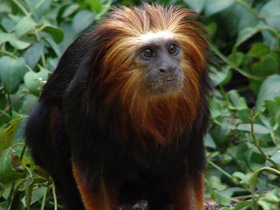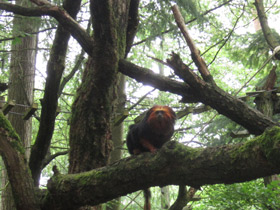The golden-headed lion tamarin (Leontopithecus chrysomelas), also the golden-headed tamarin
Description
Leontopithecus chrysomelas is a species of platyrrhine primate in the family Callitrichidae.
Leontopithecus chrysomelas is endemic to Brazil, where it is found in the lowland rainforests of the state of Bahia. The tusks of these monkeys are relatively large, the head and body small; the fur is mostly black, the mane golden. The forelimbs and tail also have golden markings. The body length of Leontopithecus chrysomelas ranges from 200-336 mm and the tail length from 315-400 mm. Sexual dimorphism is not pronounced in these primates.
Habitat and nutrition
Leontopithecus chrysomelas prefers to settle in humid primary tropical rainforests with dense undergrowth and swampy areas, but is also found in secondary forests or abandoned plantations. They forage in trees, usually between 13 and 19 metres high.
These monkeys are omnivorous and their diet is very broad, however, over 79% of their food is ripe fruit. Leontopithecus chrysomelas also feeds on plant buds, flowers, nectar, insects and their larvae, spiders, molluscs, small vertebrates (frogs, lizards, small snakes) and bird eggs. They supplement their diet with tree sap, although this is rarely consumed by the species. The territory of the group is quite large for such small primates and exceeds 100 ha, but zoologists report that Leontopithecus chrysomelas spends about 50% of its time in only 11% of its territory. Their presence in a particular forest area is more related to food availability than to territory defence. The territories of the different groups overlap a lot, but even neighbouring groups hardly interact with each other. However, if clashes occur, the animals behave aggressively, making frightening sounds and provoking fights. Leontopithecus chrysomelas are usually active for about 12 hours a day: they start their day between 5 and 9 am and finish it at 6 pm. They sleep in holes, with the whole group sleeping in one hole.
Social behaviour and reproduction
The number of individuals in the group varies from 2 to 11. The group may contain several adults of both sexes, but males usually outnumber females. If there are two adult females, only one of them breeds. There may be one to three offspring of different ages from that female in the group. If the second female gives birth to cubs, the dominant female is very aggressive towards them and may even kill them.
Most offspring of Leontopithecus chrysomelas are born between October and April, although in the tropics fruits ripen at any time of the year. Scientists believe that seasonality in these primates is determined by photoperiodism and may be a behavioural adaptation to raise young during longer daylight hours.
Like many Callitrichidae, Leontopithecus chrysomelas is characterised by cooperative rearing, in which all members of the group carry the young, play with them, protect them from predators and even bring them food scraps. The fact is that the young of Leontopithecus chrysomelas are born very large and weigh up to 10% of their mother's weight. At the same time, Leontopithecus chrysomelas often give birth to twins and the females simply could not carry two heavy young on their backs.
Most of the care is taken over by the males and the older siblings (thus gaining experience in rearing). During the first two days after birth, the calf is carried by the female alone, on the third day she allows the male to pick it up and on the fifth day all members of the group are allowed to do so.
At 4 weeks of age, the calf is able to travel unaided 15% of the time, but even at 7 weeks, one of the adults will always be with her just in case. By the fifth week, the helpers begin to share food with the young and this behaviour peaks at 12 weeks of age. When the cubs are 5 months old, the other members of the group stop feeding them. However, the parents continue to feed them until they are 21 months old.
The youngest calves are usually given insects to eat, while the older calves are given a variety of foods.
Quantity
The species was granted Near Threatened status by the International Union for Conservation of Nature in 1982. This status has been reaffirmed several times since then. In 2008, the population is estimated to have declined by more than 50% in three generations (21 years). The main threat to the population is habitat destruction and fragmentation.
Range
Its home range may be large in order to provide a sufficient amount of easily depletable fruit and prey foraging sites over the long term. On average it defended home ranges that are 123 hectares. Space is not necessarily used exclusively, and golden-headed lion tamarin groups may occupy areas that overlap to some extent at their borders.
Conservation
The IUCN Red List categorized the golden-headed lion tamarin as endangered in 1982. According to Costa, Leite, Mendes, and Ditchfield, Brazil accounts for about 14% of the world's biota and has the largest mammal diversity in the world, with more than 530 described species. According to the Brazilian Institute of Environment and Renewable Natural Resources (IBAMA), out of the 24 endemic primates of the Atlantic Forest, 15 of them are threatened. Brazil's Atlantic forest is one of the most endangered ecosystems on earth, in which the majority of the original forest has been cleared for farming, mining, ranching & expanding urban centers. The four species of lion tamarin have been studied and managed extensively, combining research on ecology, captive breeding, reintroduction and translocation, habitat restoration and protection, and environmental education.
Threats to survival
The forest of Bahia, Brazil has been reduced to 2% due to farming, ranching, mining and urbanization. The Atlantic Forest is highly fragmented, and the disappearance of this habitat is the main reason for the golden-headed lion tamarin's decline. The majority of the forest was once dominated by cocoa plants through a method known as cabruca. This is a system of shade cropping in which the middle and understory trees are removed and replaced with cocoa trees. Although the tamarin's habitat is reduced, it still leaves old growth trees which give the tamarins a place to forage and to sleep. In 1989 farmers abandoned their cocoa plants due to a fungus that attacked their harvest. The old growth which was once available abundantly to the tamarins was destroyed to harvest timber, clear land for cattle or grow other crops. The Atlantic Forest is now a mosaic of primary and secondary forest, and agricultural lands.














































